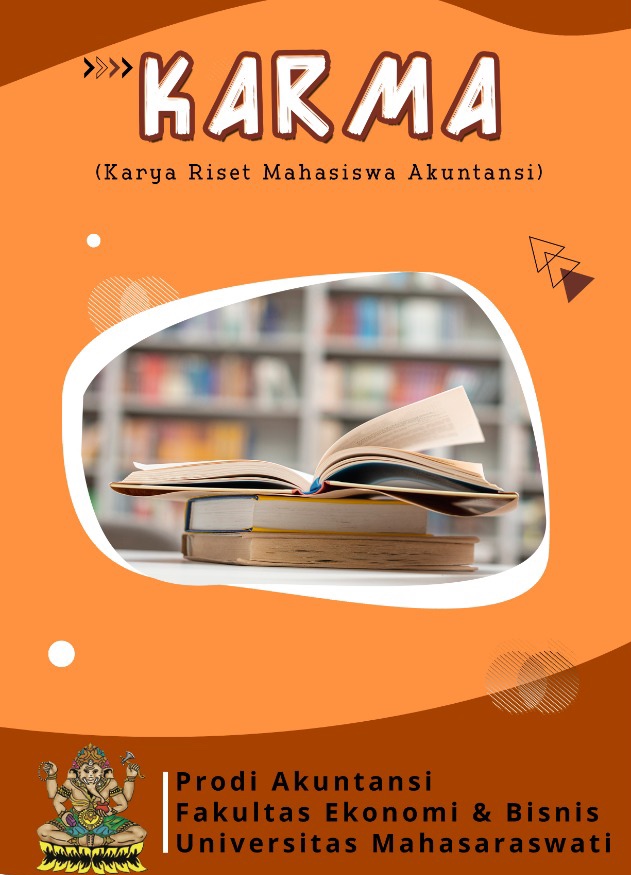Pengaruh Fraud Diamond Terhadap Kecurangan Laporan Keuangan Pada Perusahaan Manufaktur Yang Terdaftar Di Bursa Efek Indonesia (BEI) (Periode 2016-2018)
Keywords:
Fraud triangle, SAS 99, Fraud Diamond, Financial Statement Fraud, Fraud.Abstract
Financial condition of the company can be reflected in the company's financial statements. However, there are many gaps in the financial statements that can be a space for management and certain elements to commit fraud (Fraud) on the financial statements. This study was conducted with the aim of analyzing the influence of variables from the development of Cressey's fraud triangle, namely diamond fraud, stated by Wolfe and Hermanson (2009), namely financial targets, financial stability, nature of industry, effective monitoring, change in auditor and capability to report fraud finance. The research sample used was 49 manufacturing companies on the Indonesia Stock Exchange in the 2016-2018 period. The type of data used is secondary data, in the form of annual reports of companies listing on the Indonesia Stock Exchange during the 2016-2018 period. Hypothesis testing is done by using multiple linear regression methods with SPSS 21 software. The results showed that the financial stability variable which is proxied by the ratio of changes in total assets, the nature of industry variable which is proxied by the ratio of change in accounts receivable, the effective monitoring variable which is proxied by the ratio of independent commissioners, change in auditor, and Capability which is proxied by changes in directors has no effect against fraudulent financial statements. Financial targets proxied by Return on Assets have a positive effect on financial statement fraud.
References
ACFE.2002. Fraud Wxaminers manual, Third Edition. New York.
AICPA. (2002). AU Section 316 Consideration of Fraud in a Financial, (99, 113), 167–218.
Annisya, Lindrianasari, dan Asmaranti. 2016. faktor-faktor yang mendorong terjadinya kecurangan laporan keuangan dengan analisis fraud diamond pada Perusahaan Go-public yang Terdaftar di Bursa Efek Indonesia Periode 2013-2015. Skripsi Akuntansi pada Fakultas Ekonomika dan Bisnis Universitas Diponegoro.
Cressey, D 1953. The Internal Auditor as Fraud Buster. Managerial Auditing Journal. MCB University Press.
Dechow, P. M., Ge, W., Larson, C. R., dan Sloan, R. G. (2009). Predicting Material Accounting Misstatements. Contemporary Accounting Research, 28(1), 17–82.
Dewi, G. A. K. R. S. 2012. Pengaruh Moralitas Individu dan Pengendalian Internal pada Kecurangan Akuntansi (Studi Eksperimen pada Pemerintah Daerah Provinsi Bali).Tesis,Universitas Udayana.
Ghozali, Imam. 2016. Aplikasi Analisis Multivariete dengan Program IBM SPSS 21. Semarang: Badan Penerbit Universitas Diponegoro.
Jensen, M. C., dan Meckling, W. H. (1976). Theory of the Firm : Managerial Behavior , Agency Costs and Ownership Structure Theory of the Firm : Managerial Behavior , Agency Costs and Ownership Structure. Journal of Financial Economics, 3(4), 305–306.
Kasmir (2013). Analisis Laporan Keuangan.Jakarta: PT Raja Grafindo Persada.
Lou, Y. I., and M. L. Wang. 2009. Fraud Risk Factor Of The Fraud Triangle Assessing The Likelihood Of Fraudulent Financial Reporting. Journal of Business and Economic Research, Vol. 7, No. 2, h. 62-66.
Mardiana, Lia. 2013. Analisis Kecurangan Laporan Keuangan: Studi Kasus pada PT. Bumi Resources, Tbk dan PT. Berau Coal Energy, Tbk. Bina Nusantara University. Jakarta.Nauval, Muhammad. 2014. Analisis Faktor-faktor yang Berpengaruh terhadap Kecendrungan Financial Statement Fraud dalam Perspektif Fraud Triangle. Skripsi Akuntansi pada Universitas Diponegoro, Semarang.
Rahmanti, Martantya Maudy. 2013. Pendeteksian Kecurangan Laporan Keuangan Melalui Faktor Risiko Tekanan Dan Peluang. Diponegoro Journal of Accounting. Vol. 2, Hal. 1-12
Rini, Viva Yustitia. 2012. Analisis Prediksi Potensi Risiko Fraudulent Financial Statement Melalui Fraud Score Model. Diponegoro Journal of Accounting. Vol. 1, No. 1, h. 1-15
Sihombing, Kennedy S. 2014. Analisis Fraud Diamond dalam Mendeteksi Financial Statement Fraud: Studi Empiris pada Perusahaan Manufaktur yang Terdaftar di Bursa Efek Indonesia (BEI) Tahun 2010-2012. Skripsi. Tidak Dipublikasikan. Universitas Diponegoro.
Skousen, C.J., K.R. Smith, dan C.J. Wright. 2009. Detecting and Predicting Financial Statement Fraud : The Effectiveness of The Fraud Triangle and SAS no. 99. Journal of Corporate Governance and Firm Performances, Vol 13, h. 53-81
Sugiyono. 2013. Metode penelitian pendidikan (Pendekatan kuantitatif, kualitatif, dan R&D). Bandung: Alfabeta.
Summers, S L., & Sweeny, J. T. 1998. Fraudulently Misstated Financial Statements and Insider Trading: An Empirical Analysis. The Accounting Review, 73, 131-146.
Wolfe, D. T., dan Hermanson, D. R. (2004). The Fraud Diamond : Considering the Four Elements of Fraud. CPA Journal, 12(74), 38–


